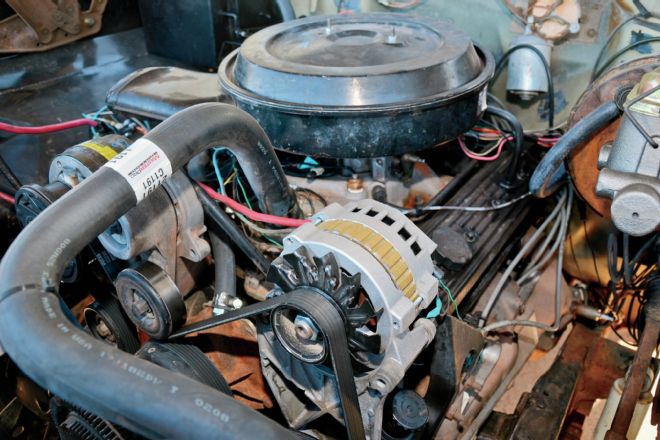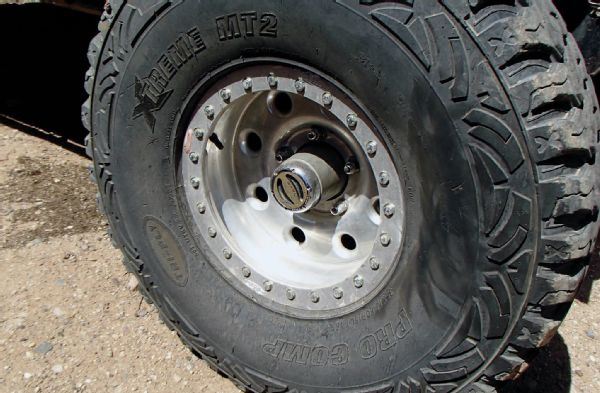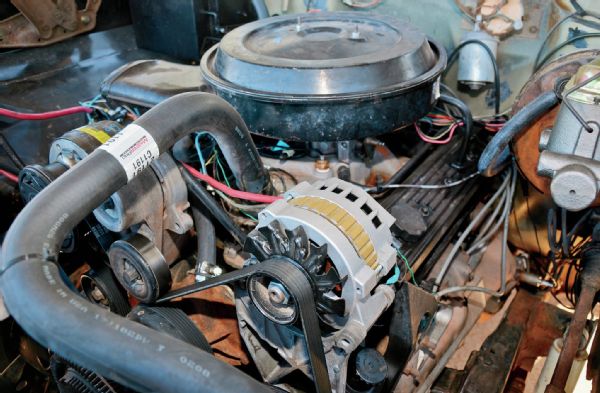
 Verne Simons
Senior Editor, Jp
Verne Simons
Senior Editor, Jp
Unitbearing Dana 30, Locking Hubs, and a CJ Bolt Pattern?
I saw a couple of pictures of the Shrink Ray TJ in the May ’14 issue (“Putting Down Numbers” and Your Jeep) and the Jeep looked like it had 1⁄2-ton locking hubs. I remember when you had beadlocks installed on those old Weld wheels and they had the 5-on-5.5-inch bolt pattern. The Shrink Ray UC Jeep didn’t look like it had the Reid Racing outer knuckles on it, and it still looked like it had the Dana 30 under it. Is there another way to get the 1⁄2-ton hubs and the 5-on-5.5-inch bolt pattern on the Dana 30?
Chuck
Via email

Chuck, I kind of feel like I have already answered this question, and honestly, I may have. So on my little TJ I am running an old Warn Full Float kit for a TJ/XJ/ZJ Dana 30. I got it from a friend when I traded him for a Warn Full Float kit for an early CJ Dana 44 rear axle. The parts on my Jeep allow the use of chromoly shafts, chromoly U-joints, and external-spline locking hubs. So why am I telling you about this no-longer-available product? Just to rub it in? Nope, I am telling you because there are a couple of options to get the traditional CJ bolt pattern (5-on-5.5-inch). We’ve heard of similar conversions from companies like Spyntek and Yukon Gear. These conversions will accomplish the same effect as the old Warn kit. However, all of these are expensive and may cost somewhere near $1,500. If you only want the 5-on-5.5-inch bolt pattern, and don’t need a locking-hub and all the fancy parts, for a lot less cash you can run some wheel spacer/adapters available from several aftermarket manufacturers. Just be sure you are using quality spacers/adapters and not cheaply made ones. You don’t want a wheel coming off at the wrong time.
GM Drivetrain in a J20
I’m looking for some advice. I own a ’80 J20 with a blown head gasket and no Reverse. I also own a ’89 Suburban with a body has rusted away from its otherwise pristine drivetrain with only 89,000 miles on the clock. My plan is to swap the motor and tranny into the Jeep. Now, before I open this can of worms, I was wondering what would be the best way to go about this. I want to try and keep the throttle body injection (TBI) and the overdrive tranny. So, that brings up a few questions right off the bat.
1. Fuel: What will I need to get to keep the TBI happy, and is there anything I can rob off the Suburban?
2. Wiring: What would be the best route for the wiring harness and computer for the motor and tranny. Again, what could I save money on by robbing the Sub?
3. T-case: As I’m sure you know, one has a passenger-side drop and the other has a driver-side drop. Will my T-case in the Jeep bolt up to the Chevy trans or will I need an adaptor? Do you foresee any other issues I may have overlooked or may need to keep in mind?
I, like most everyone else nowadays, have a budget of a paperboy with maybe a side job of mowing lawns. Any advice you can give would help out a lot. Thank you for your time.
Dustin Milligan
Columbus, Nebraska

Dustin, this is a great swap, and it can be done relatively inexpensively, especially since you have both vehicles there to swap parts between. First, on the fuel front, you are going to want source the TBI and the hoses that head down the back of the engine and bellhousing to the frame. You can use these by cutting and flaring the metal lines (not the flex hoses but the solid lines). You also can re-use the fittings that allow the use of the stock inline fuel filter. From there, you’ll either have to add an external e-2000 fuel pump, or you may be able to retro-fit the Suburban’s tank into the J20. Not sure if that would work, but if it would, you could keep the whole fuel system GM. As far as wiring, if you are pretty good at automotive wiring, you are going to want to label and carefully remove the GM engine wiring harness and computer. Also, you may want to grab the wiring and diagnostic port. Then, check out the interwebs for wiring diagrams for TBI swaps. There are tons of forums with information (and misinformation) on what wires need to be trimmed from the wiring harness. Maybe one of the best is actually on an IH forum (binderplanet.com) where you can check out the step-by-step fuel injection conversion, but keep in mind that you are not swapping to a non-GM engine and you are going to use the GM transmission. At least that should mean you won’t need to re-flash the computer. If you are not into wiring, there are several companies that can sell you a GM TBI swap harness. Howell Engine Development, Painless Performance, and Hotwire Auto come to mind.
As far as the T-case, I’m guessing your ’80 J20 still has its original transfer case, which is either a NP219 or an NP208. Both of these are pretty good transfer cases and should be fairly easy to rebuild, which you might want to do before getting an adapter to mate the T-case to your GM 700R4 transmission. Check out Novak Conversions for the adapter.
Otherwise, if you are handy, you might be able to reuse parts of the Chevy’s exhaust and/or throttle cable. You can also either make your own engine swap motor mounts or see what Novak has for sale that will work in a J20. Good luck and send us some pictures when the truck is done.
Gently Loving a JK
I know this may be old hat to you and that you have probably answered this question a million times before, but I seem to be getting a bit of a round around from my local Jeep dealer when I ask what aftermarket oil specs would be the equivalent (or better) than the OEM Jeep oil used in the manual transmission of a ’07 Wrangler.
The manual says that it’s a “lifetime product” and never needs to be changed; if you believe that, I got a bridge I can sell you. I am told that there is no substitute, and that only the Mopar oil at $22.45 per quart is what’s needed!
I plan to keep my JK for a long time. It currently has 49,000 miles, and it would seem prudent to do an oil change with the best oil available, especially since I am the third owner, don’t have previous maintenance records, and have no idea how the vehicle was treated before my gentle, loving touch. The vehicle has mostly on-road use, and off-road use has been mild.
1. So, in your experience, what aftermarket oil would you use for a manual transmission in the ’07 JK? Or would you stick to the Mopar product?
2. Also, the Jeep manual lists specs for both front and rear differentials, so I am planning to use “Mobil 1” full-synthetic 75W-90 (LSD). Is that OK?
Thanks for your help, and keep up your excellent advice in the “Your Jeep” section. It’s been very helpful.
Bernie Kressner
Appleton, WI
Actually Bernie, I have never had this question, and it’s a good one. First, I would start with inspecting your transmissions oil and check to see if it is full. Chances are its fine, and if it is, then why “fix” what ain’t broke? To do this, just pull the fill plug and stick your pinky finger in there, and see what comes back out with it. If the oil looks clean, but is low I’d add some of the expensive Mopar stuff and keep my eye on it. If it’s dirty, dark, glittery, or milky, well, that’s probably a good reason to change it. Our own Pete Trasborg has been running Royal Purple Syncromax in Jp’s ’07 JK that recently got a new NSG370 (the same six-speed you have) and in his MJ with the same model transmission. So you could really go with either the Royal Purple Syncromax or the recommended expensive Mopar fluid.
As far as the oil in the axles, we took a gander at the owner’s manual in our ’13 JK. It says the front axle should be filled with SAE 80W-90 API GL-5 oil. So you should be able to run any 80W-90 gear oil rated at GL-5 in your front axle which should be just about the same as our ’13 JK’s. As for the rear axle our owner’s manual recommends the same fluid for the rear unless you do any trailer towing. In that case they suggest Mopar Synthetic Gear and Axle Lubricant SAE 75W-140. That’s real nice for them, and is meant to ensure future sales, but the truth is you could use any synthetic gear oil with the 75W-140 rating. They also state that Wrangler models with a Trac-Lok rear differential will require a limited-slip additive. That means if your Jeep has a Trac-Lok you should use an additive or chose a gear oil already pre-mixed with a limited-slip additive. Basically, choose an oil that meets these specifications from a name-brand company you trust.
Give Me Liberty, or Some Hints on Modifing a Liberty
I know not a lot of people have chosen to do much with the new Liberty but it seems to perform up to the Jeep standard. I want to put some aggressive tires on my Liberty (it’s a ’12 Liberty Latitude) but can’t seem to figure out what would be best. Do you have any suggestions?
Suresh Sandhu
Via FaceBook
Well Suresh, while it may seem that you are alone in a Wrangler/CJ/Cherokee world, you are not. If I were you, I would start searching the Google webs because there are several Liberty forums out there in the Internet world. When we saw your question, we spent some time looking at lostjeeps.com, which has a ton of info on what can and should be modified on your Liberty. I would look into the largest size tire your KK Liberty can handle without a lift kit. Want more? There are also lift kits available for your Jeep that should allow more flex and larger tire fitment. That includes a full coil replacement suspension lift from Skyjacker. Libertys look great, but they look way better with big tires and a suspension lift. As far as suggesting a specific tire, it really depends on if you want a mud terrain or an all terrain for your KK, and that usually depends on what you want to do with your Libby. Once you have that figured out, check out “The Hot Sheet: 33 Off-Road Tires Tested” on our web site at: fourwheeler.com/how-to/wheels-tires/154-1203-the-hot-sheet-33-off-road-tires-tested.
CJ-5 Tub Identification
Hello, I was wondering if you could help. I built a CJ-5 out of a couple of different Jeeps. The first one, which is the frame and drivetrain, is titled as a ’64 with the F-head and T-90. The body was toast when I got it, so I picked up another body. The problem is its newer, but I don’t know how to tell what year it is. I have looked for a way online with no answer to my question. I have noticed that the older body styles have a V-notch above the back tires and the newer ones don’t. What is this notch for? My main question is how do I figure out what soft top I need to buy? Does it matter if I used an older windshield on a newer body? Any help would be appreciated.
Chris Steed
Via email
There are several ways to tell the difference between different CJ-5s. Basically, CJ-5s from ’55-’75 interchange many parts like windshields, the tub, tailgates, and so on. Although ’55-’71 share a short hood and front fenders, ’72-’83 share longer front fenders and hood. The ’76-’83 tubs are quite different and use a different windshield that sits at a different angle meaning there are two soft tops for CJ-5s from ‘55-‘75 and ‘76-‘83. Probably the easiest way to visually differentiate between the “early” and “intermediate” tubs (’55-’75) and the “late” (’76-’83) CJ-5 tub is to look for a toolbox in the area below the passenger-side seat. Also, there are other differences in the floors and the tailgate openings (when present) between the two tubs. Confused yet? Wait, there is more. Getting back to the windshields, there are actually three, two of which will bolt to the hinges on the earlier tubs (’55-’75) and one of which will fit on the later (’76-’83) CJ-5 tub. The early windshields either have wipers that drop down from the top of the windshield or have bottom-mounted wipers an electric motor for the wipers mounted to the front of the windshield. The later (’76-’83) windshield has bottom-up wipers and a motor that is tucked inside the windshield. Oh, we could keep going, but probably the best and most reliable method is to look for the toolbox in the floor of the tub.
All right, sorry. I got a bit off track again there. It sure sounds to me like you have a later tub and an earlier chassis. With some work, you should be able to get the two together in some form of union. Just to be sure, if you end up using this later body (and not looking for an early one to better match your frame), call up Quadratec, and they will help you make sure your new soft top will fit the tub and windshield you have by getting you to take a few measurements on the Jeep.
Write Us!
Got a tech question you’re just itching to get answered? Send it on in to Jp Magazine, Your Jeep, 831 S. Douglas St., El Segundo, CA 90245, or e-mail it to verne.simons@jpmagazine.com.